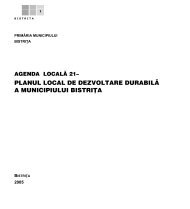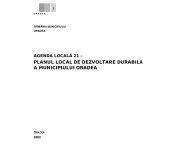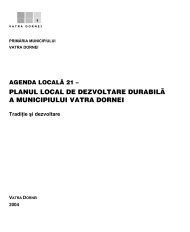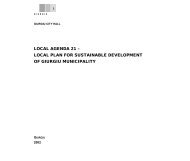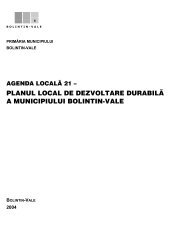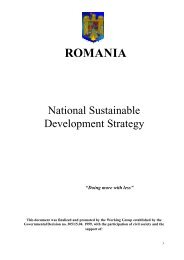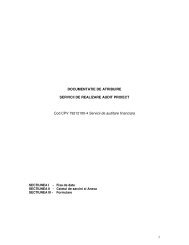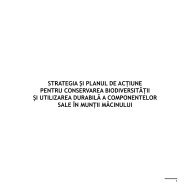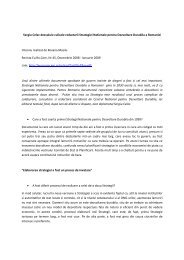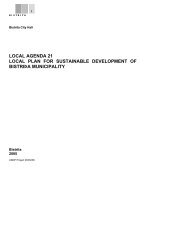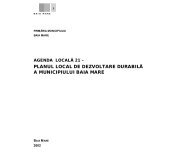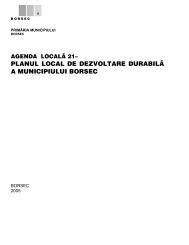Local Plan for Sustainable Development of Sibiu Municipality
Local Plan for Sustainable Development of Sibiu Municipality
Local Plan for Sustainable Development of Sibiu Municipality
Create successful ePaper yourself
Turn your PDF publications into a flip-book with our unique Google optimized e-Paper software.
49<br />
SIBIU<br />
• Reduction <strong>of</strong> poverty and social exclusion by<br />
granting needs adapted social services (the<br />
assurance <strong>of</strong> the minimum guaranteed income<br />
and <strong>of</strong> material and financial help in cooperation<br />
with NGOs, according to legislation).<br />
• Guarantee the balance between the market<br />
economy requirements and those <strong>of</strong> social<br />
protection and solidarity; a permanent<br />
relationship was established between social<br />
and economic partners and the public opinion.<br />
• Reorientation <strong>of</strong> social assistance services<br />
towards future generations, by granting<br />
sustenance and family development<br />
allowances, to fight against social<br />
marginalization.<br />
II.4.3. CHILD PROTECTION<br />
Objectives:<br />
• Closing <strong>of</strong> residential type institutions and<br />
establishment <strong>of</strong> family type services.<br />
• <strong>Development</strong> <strong>of</strong> family type alternatives.<br />
• Prevention <strong>of</strong> child abuse and child neglect.<br />
• Involvement <strong>of</strong> local communities in the<br />
observance <strong>of</strong> the children’s rights.<br />
• Educational, occupational and social integration<br />
<strong>of</strong> youths over 18 years <strong>of</strong> age who benefited<br />
from social protection.<br />
II.5. EDUCATION, CULTURE<br />
II.5.1. EDUCATION<br />
Objectives:<br />
• Improved management. An integrated<br />
educational management is ideal, based on<br />
objectives, <strong>for</strong> the improvement <strong>of</strong> educational<br />
standards.<br />
• Improved school’s role in <strong>Sibiu</strong>, the school<br />
being seen as the main educational institution<br />
<strong>for</strong> resources development and not as a<br />
“consumption” institution.<br />
• Assimilation <strong>of</strong> in<strong>for</strong>mation technology<br />
language in schools, to provide the means <strong>for</strong><br />
a new “illiteracy liquidation” <strong>of</strong> the population.<br />
• The structure <strong>of</strong> education in high school,<br />
after high school and in vocational units<br />
must be planned according to the labour<br />
market <strong>of</strong>fer. Programs will be developed in<br />
co-operation with economic units and<br />
institutions specialised in social and economic<br />
prognosis.<br />
• Thorough study <strong>of</strong> the Romanian language,<br />
history and civilisation, and <strong>of</strong> the local<br />
culture as fundamentals <strong>for</strong> the safeguarding<br />
<strong>of</strong> the national identity in the European<br />
integration and globalisation context.<br />
• The development <strong>of</strong> the education <strong>for</strong><br />
minorities and the introduction <strong>of</strong> elements <strong>of</strong><br />
intercultural education in the school curriculum.<br />
• The development <strong>of</strong> special programmes <strong>for</strong><br />
education (intensive programmes <strong>for</strong><br />
preventing school abandonment, support<br />
programmes <strong>for</strong> languages and cultures <strong>of</strong><br />
minorities, including Rroma children,<br />
programmes <strong>for</strong> the integration <strong>of</strong> children from<br />
institutions into natural or substitutive families<br />
etc.).<br />
• The improvement <strong>of</strong> the equipment <strong>of</strong><br />
school units by refurbishing and repairing the<br />
school buildings (including the construction <strong>of</strong><br />
gym halls).<br />
• The diversification <strong>of</strong> teaching staff training<br />
according to European integration spirit.<br />
• The modernisation <strong>of</strong> equipment (libraries,<br />
laboratories) <strong>for</strong> top level education.<br />
• The improvement <strong>of</strong> the educational climate,<br />
<strong>of</strong> the coherence <strong>of</strong> education institutions.<br />
• Integrated transparency and consulting in<br />
the educational <strong>of</strong>fer, <strong>for</strong> a better pr<strong>of</strong>essional<br />
orientation.<br />
II.5.2. CULTURE<br />
Objectives:<br />
• <strong>Development</strong> <strong>of</strong> public-private partnerships <strong>for</strong><br />
the exploitation <strong>of</strong> sponsorship/financing<br />
methods <strong>for</strong> culture institutions.



